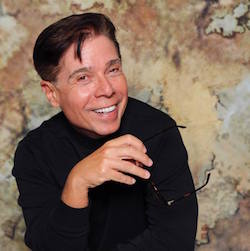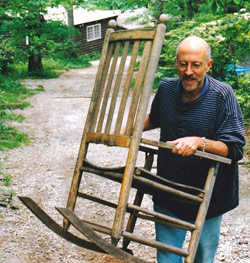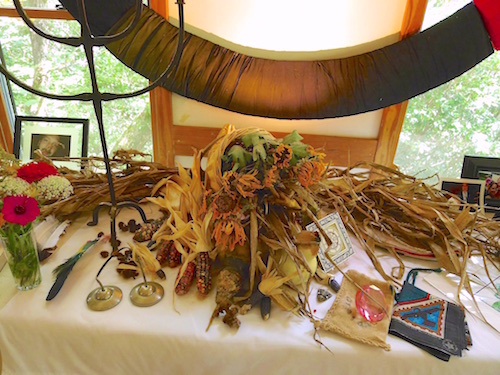This is the fourth in a series of articles about altars republished from the Visionary archives. It was originally published in the Summer 2001 issue of GSV’s Visionary journal.
Feeling Close to Spirit
by Jennings Fort

I want to be a spiritual person. So it makes sense to me that I should have a daily spiritual practice. I’ve pondered this often, thinking other GSV people must have satisfying daily rituals that make them feel one with Spirit.
I have an altar on our bedroom dresser. There are framed photos of my mother, sister, and late father. My partner, John, and I are in a photo taken on top of the fire tower at a GSV Fall Conference. I have photos of my dear friends Mark Clinard and Doug Parrot, three of my grandparents, and my uncle Jennings who died in World War II. I have a lapel pin of the One Voice Chorus in Charlotte, NC, where I sang for nine years. This gay chorus was a gift from Spirit that has helped me along my spiritual path. In the middle is a candle. I have it in a small clay cauldron my friend, Larry Jackson, gave me. Underneath, there’s a tile that says “I am my beloved’s and my beloved is mine” John gave me when I first moved in with him. Sometimes I burn incense there, but not often. Between work, the gym, errands and just vegging out, I feel guilty that I neglect my altar. Sometimes, I’ll add a card from a loved one or something just to change it a little. [pullquote align=”left” cite=”” link=”” color=”” class=”” size=””]I meditate nearly every morning. It’s transcendental meditation that I learned 25 years ago. You’d think by now I would have reached some kind of cosmic consciousness, but I really haven’t. [/pullquote]
I meditate nearly every morning. It’s transcendental meditation that I learned 25 years ago. You’d think by now I would have reached some kind of cosmic consciousness, but I really haven’t. I’ve meditated off and on for years. It’s a way of easing into the day. After 20 minutes of reciting my mantra, I pray, thanking Spirit for my life, for John, asking that I don’t expect too much or too little from him, for my mother and her health and the well-being of Mark and Doug. Then I ask for help to let go of anger that I have about my father, who drank himself to death eight years ago. Even if my meditation isn’t the best, I still offer my prayers to Spirit and I think Spirit listens.
I meditate nearly every morning. It’s transcendental meditation that I learned 25 years ago. You’d think by now I would have reached some kind of cosmic consciousness, but I really haven’t.
One of the most spiritual things for me right now is making compost. I love gardening. It’s a passion handed down by my mother. I collect all the coffee grounds, banana peelings, eggshells and rotten things from the refrigerator in a brass bowl on our kitchen countertop. When it’s full, I take it to the dogwood tree in the the back of the yard. In this shady and green place, I pour the food scraps, rousing the flies and gnats. I stir the pile and take in the sweet rotting smell. Sometimes I’ll grab a handful of compost and feel it between my fingers, thinking about how this will nourish the flowers we plant. I’ll linger a moment, watching the insects and the worms, and just enjoy the quiet. It makes me feel good to think I’m helping the earth, even in this small way. But the best part is the quiet. Maybe between my altar, meditation and composting, these few quiet moments are enough. Then, at least, I feel the warmth of Spirit beside me.
This article was originally published in the Summer 2001 issue of GSV’s Visionary journal. Read the original article in the Visionary.



 My daily practice is Yoga, breathing, Chi Gung, meditation and Planetary Acupuncture. Decades ago I studied Yoga with the Pierce Program in Atlanta with Martin Pierce’s first Men’s Class. Then for several years I attended a “Wellness Workout” taught by Jean Dunham that combined breathing, stretching, Skinner Releasing and dancing. Here I was also introduced to the Tao Animal Exercises in which you “become” different animals to energize different body systems.
My daily practice is Yoga, breathing, Chi Gung, meditation and Planetary Acupuncture. Decades ago I studied Yoga with the Pierce Program in Atlanta with Martin Pierce’s first Men’s Class. Then for several years I attended a “Wellness Workout” taught by Jean Dunham that combined breathing, stretching, Skinner Releasing and dancing. Here I was also introduced to the Tao Animal Exercises in which you “become” different animals to energize different body systems.


